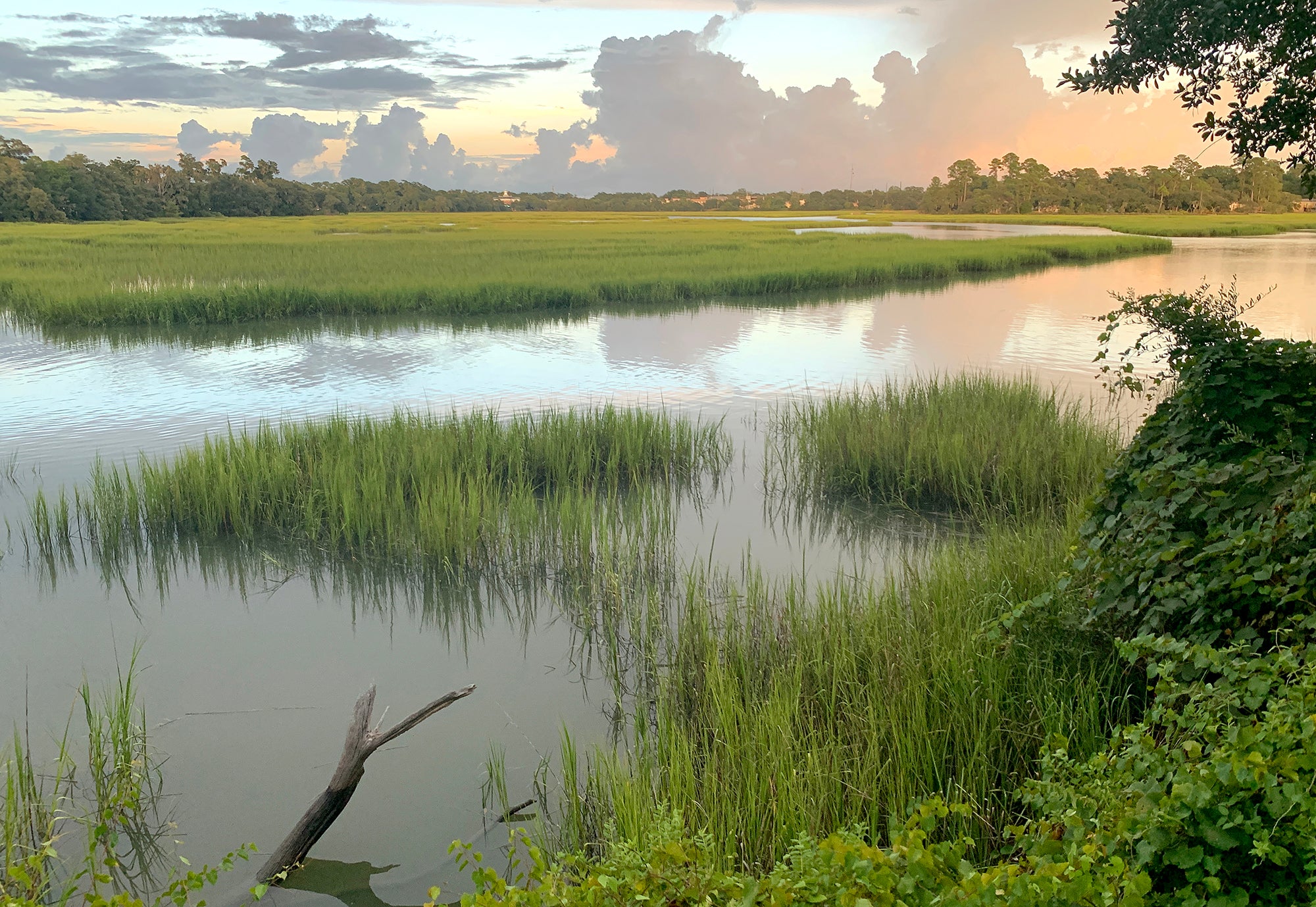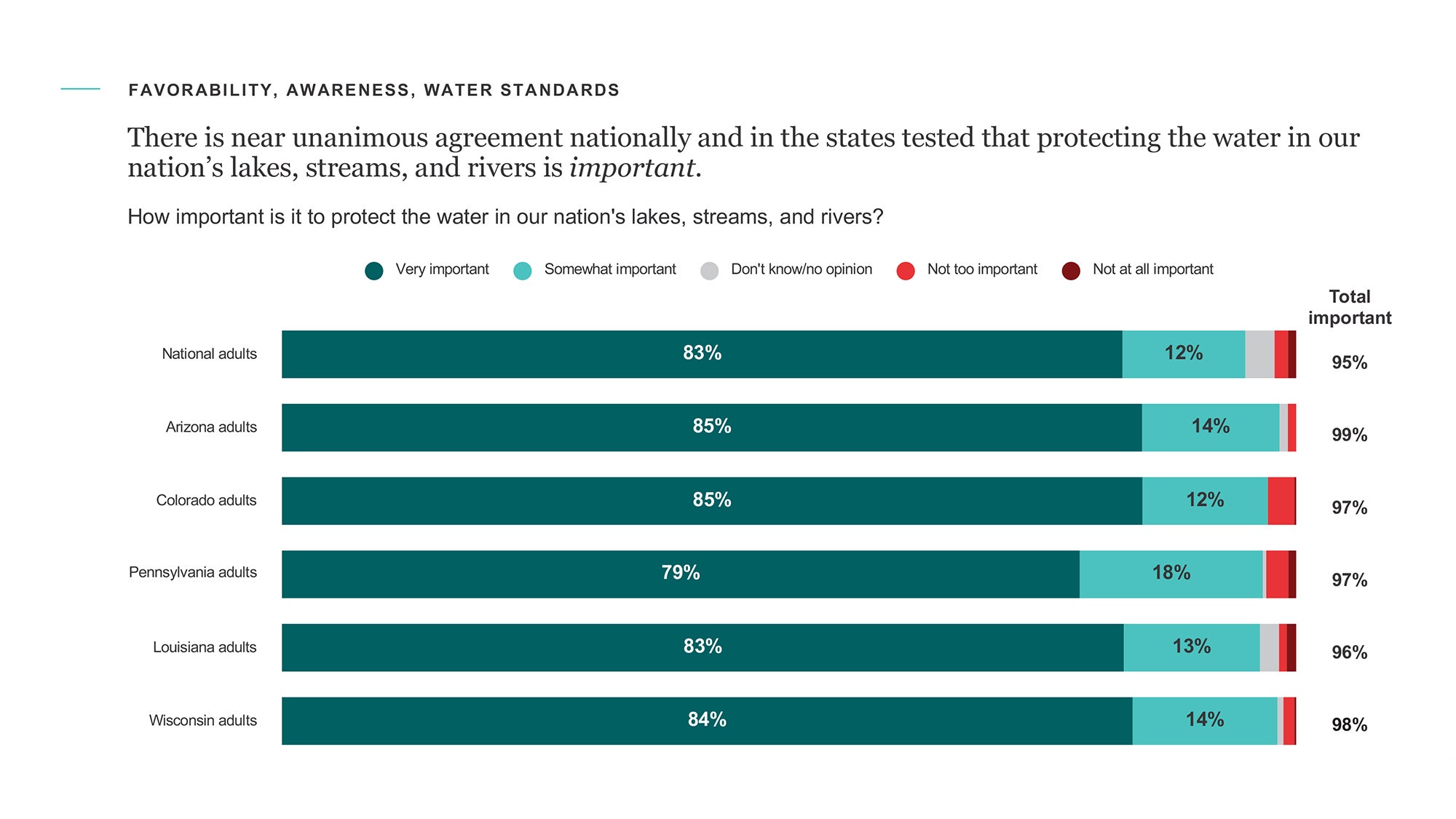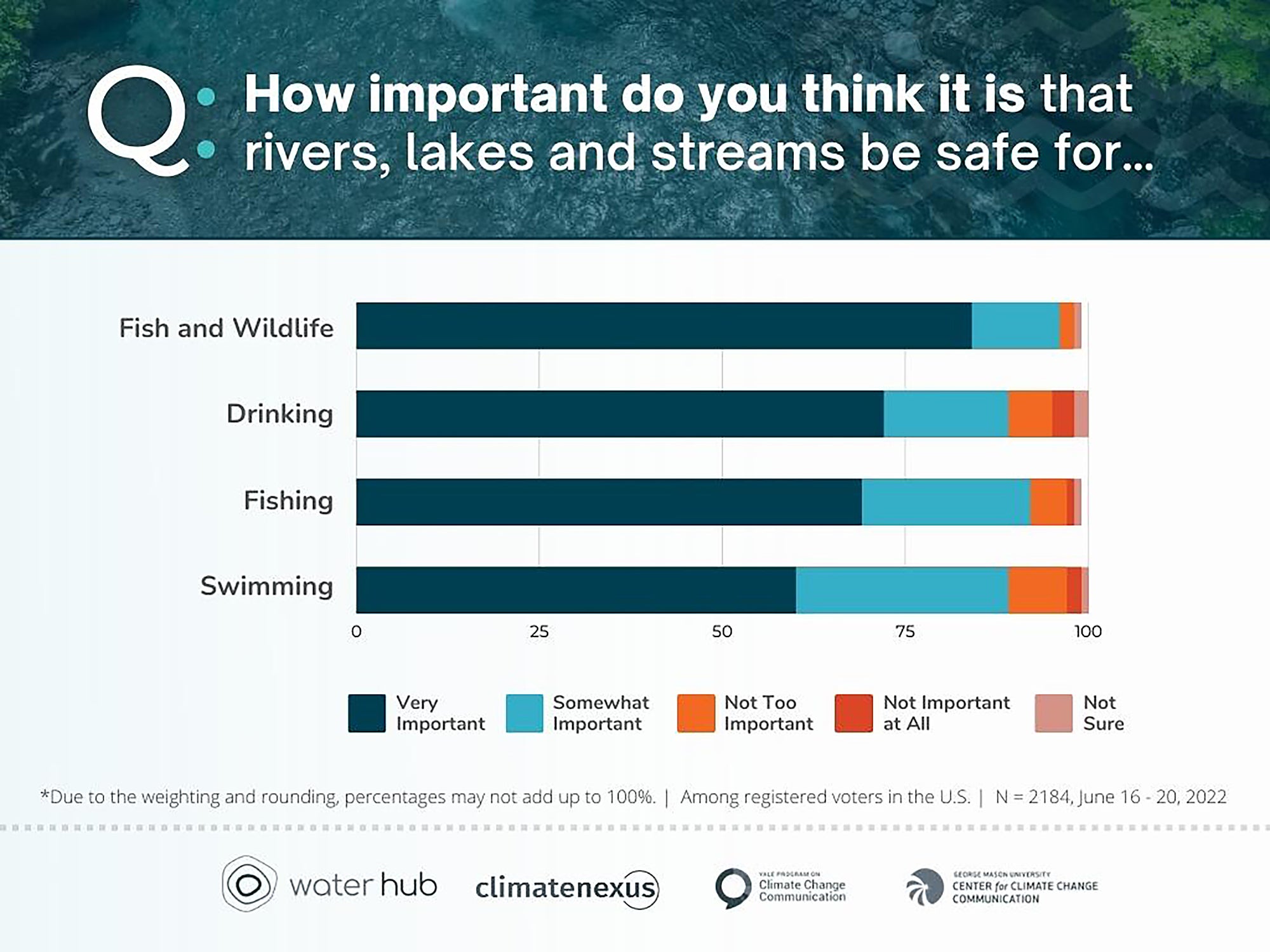In the Fight for Clean Water, Industry Spreads Disinformation
Some lawmakers and their industry supporters are spreading clean water myths. Here are the facts.

This page was published 2 years ago. Find the latest on Earthjustice’s work.
Clean water is something we all share as a fundamental need. It connects us all. Most people understand that, which is why people from all backgrounds, places, and political beliefs support protecting our water.

(Source: Walton Family Foundation)
Yet, Republicans in Congress and corporate polluters have spent the better part of the last two decades undermining overwhelming scientific consensus and aggressively attacking the Clean Water Act. They seem adamant to send us back to the days where rivers were on fire and polluters could destroy waterways for profit with impunity. Where most of us see wetlands as ecosystems that protect us from flooding, provide food, and are critical to wildlife, industry still views them as “wasteland” waiting to be filled in, destroyed, and developed for profit. Knowing that public opinion was not in their favor, Republicans have been relying on spreading disinformation to advance their deregulatory agenda.
There’s a key difference between misinformation and disinformation that’s important to understand. Misinformation is when you share false or inaccurate information and have gotten the facts wrong. Disinformation is false information deliberately spread to mislead and manipulate people’s beliefs and values. This distinction reveals the motivation behind the Republicans political playbook: they are hellbent pursuing deregulatory policies that are politically unpopular and benefit very few, but want people to believe that it was done in their best interest.

(Source: Water Hub)
During the Trump administration, industry efforts coalesced around the “Dirty Water Rule” — the single greatest reduction in protections for our waters in the country’s history. Two federal courts have since scrapped that rule. Republicans are now focusing their efforts on spreading disinformation about the Biden administration’s latest water safeguard rule that would reinstate protections to ensure polluters can be stopped from recklessly bulldozing wetlands and dumping waste in streams.
This new rule codifies the practices employed by the Environmental Protection Agency (EPA) and the U.S. Army Corp of Engineers since 1986, with some new clarifications and modifications. It also defines what waters are covered by this law and how agencies make that determination.
Still, Republicans are frantically regurgitating many of the same tired, decades-old talking points they have been using for well over a decade in an attempt to justify ignoring what many of their constituents support: sound, strong protections for our waterways and wetlands.
On behalf of reasonable people everywhere who understand the importance of protected rivers and streams, of sustainable water supply, of wetlands protecting us from floods, and of clean drinking water, let us dispel some of this disinformation.
1. The new Biden Rule is going to ruin farmers’ lives
During a hearing earlier this month, House Republicans and their friends from the corporate agribusiness and insurance giant American Farm Bureau Federation pulled out all the stops to fearmonger about the administration’s new rule, decrying it as an example of regulatory overreach that would harm farmers across the country. The reality is very different.
The Clean Water Act has very few agriculture regulations in the first place, and this rule does not change that at all. Most farming activities have been exempt from regulation for decades, many since the Act’s creation, and that remains true today. In fact, these exemptions are a glaring weakness in the Act because agricultural runoff and pollution are responsible for contaminating almost half of the waterways that fail to meet acceptable standards.
In their economic analysis for this new rule, EPA looked at permits issued to industry from 2011 to 2020, to see what sectors might be most affected by this new rule. Permits related to agriculture made up about half of one percent of the 420,000 permits issued by the agencies, most of which were issued to giant animal feeding operations that generate tons of manure and water pollution.
Congress and EPA have bent over backwards to accommodate farmers and the industrial agriculture industry for years when it comes to the Clean Water Act. Yet, the Farm Bureau continues their disinformation campaign in order to inspire unfounded fear in farmers and elected officials, and to ensure that gigantic corporate agrifarms can continue polluting near low-income families.
2. It’s hard to follow the law and abide by the Clean Water Act
Thousands of Clean Water Act permits are issued every year by the Army Corps of Engineers. Similarly, the Army Corps makes thousands of jurisdictional determinations under the act every year. Most of these happen without issue, because the Army Corps have been making these determinations for almost five decades under the leadership of both Republican and Democratic administrations.
If a landowner is not sure whether a water feature on their property needs a permit, EPA has a fact sheet, and the new rule has a section that is a little over 10 pages long to help. If a landowner wants further help, the Army Corps of Engineers offers reviews and jurisdictional help entirely for free. Most alleged “Waters of the US” horror stories are wildly exaggerated and, in reality, are flagrant violations of the law. Look behind the smoke and mirrors of these stories and you will often find someone who knew full well they were destroying waters and violating the law, and didn’t care.
3. This rule is a disaster for development and affordable housing.
Much of the consternation from industry groups — like the National Association of Homebuilders and the National, Stone, Sand, and Gravel Association — over this issue through the years stems from their perceived entitlement to develop any and all land and waterways without second thoughts about the consequences. Testimony during the February congressional hearing mentioned the cost of compliance with regulation and framed it as creating an affordable housing issue, an incredibly cynical and misleading ploy.
Absent from their testimony is the fact that their greedy drive to develop in any and all wetlands leads directly to flooding in places like Houston and Miami after storms (remember Hurricane Harvey’s devastation?). Saddling communities with the emotional and financial burden of flooding is especially abhorrent during an era of increased climate-induced storms and flooding.
While developers may profit, the damage from losing wetlands costs communities dearly, especially in more vulnerable areas. A study in Proceedings of the National Academy of Sciences showed a correlation between loss of wetlands and increased costs of damages. (The New York Times ran an incredible story just this month that showed the human and economic costs of this for families in Texas.)
On the other hand, we all stand to benefit when our waterways are protected. Improved water quality means more recreation on rivers, clean drinking water, better fishing and hunting, safer communities, and yes, improved home values. It’s common sense.
4. “SCOTUS before WOTUS”
Another common refrain during the hearing was that EPA should have waited for the Supreme Court to issue a decision in Sackett v. EPA, heard earlier this session, before promulgating a rule. For those of you unfamiliar with this case, the plaintiffs and their allies have argued for a radical judicial re-write of the Clean Water Act that would limit the law’s application, potentially removing protections from critical waterways, like streams and wetlands. Critics claim that the EPA’s new rule creates uncertainty and that the EPA may have to change their regulations to comply with the Supreme Court’s decision.
In reality, the Biden administration rule has been in the works since long before the Supreme Court decided to take the Sackett case in an unprecedented act of judicial overreach. This move flies in the face of the Court’s own rules determining what cases they decide to hear. Plus, the Court already heard arguments and issued a decision over this very topic in Rapanos v. EPA in 2006.
The Court knew the agencies were close to finalizing a rule addressing the very topic presented in the Sackett case. Despite this, the Court decided to hear the case anyways, holding oral argument just a few months before the rule was finalized. The extensive scientific record that accompanies this new rule highlights the scale and complexity of the technical issues that agencies have considered for decades to implement the Clean Water Act, and further illustrates why the court should leave the science to the scientists, rather than rewriting the law from the bench.
The Supreme Court is who acted prematurely. The Court should be allowing the government agencies tasked with enacting the law to implement the Clean Water Act as written by Congress with the input and expertise of best scientists in the field. Instead, the Court decided to step in ahead of time and try to override that work.
5. Republicans support protecting wetlands and support clean water
Perhaps the biggest lie reiterated through the hearing was from members of the Republican party, who were bashing the Biden administration’s new rule while also claiming to support clean water.
For example, numerous Republican members and their witnesses assured “nobody disputes the value of wetlands.” An interesting point to make, since many of these same people supported Trump’s Dirty Water Rule and none of them questioned why the administration ignored the benefits of wetlands in their economic analysis. None of them raised an eyebrow when the Trump EPA explained that calculating the benefits of wetlands was “too complicated” and decided to omit them entirely before removing protections for wetlands across the country.
The good news is many environmental advocates and scientists have been able to supply the calculations that Trump’s people conveniently decided to ignore. Thanks to their hard work, we have copious information on the value of wetlands, such as how they help reduce pollution and provide between $1.2 and 2.9 trillion in flood mitigation value for the United States, along with countless other ecosystem and economic benefits.
Similarly, despite a vast majority (84%) of voters nationwide are somewhat or very concerned about drought in the Western U.S., not a single Republican showed any concern over how developing and destroying western waters and wetlands leads to endangering water supply.
When western ephemeral streams lose protections (as 75% of them did under the Trump Dirty Water Rule) we lose key waters which capture and store rain and snowmelt and recharge underground aquifers. It’s a vicious cycle: less protections makes drought worse and drought in turn makes water quality worse. Unfortunately, these industries are more concerned with profits and much less concerned, if at all, about the toll their actions will take on communities and the environment.
Despite industry and Republican disinformation, most people, in most states — red and blue alike — understand the value of protecting our water. The scare tactics and constant gaslighting is what polluting and developing industries have cooked up as a response to that shared belief. This is why it is important that we work together and let Congress know that we will always stand up to protect our waters.
Established in 1989, Earthjustice's Policy & Legislation team works with champions in Congress to craft legislation that supports and extends our legal gains.